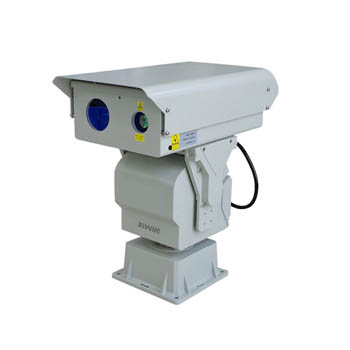
Long-range thermal imaging cameras (Long Range Thermal Camera) have become a core technology in security and surveillance due to their unique capabilities, such as non-visible light imaging, penetration through smoke/dust, and long-range detection. Below is an analysis of their key applications and technological value in the field of security monitoring:
Long-range intrusion detection: Capable of detecting moving targets (e.g., people, vehicles) several kilometers away at night or in harsh weather, making it suitable for sensitive areas like borders, military bases, and nuclear power plants.
Covert surveillance: Operates without visible light, avoiding exposure of monitoring positions. When integrated with AI, it can automatically identify trespassing and trigger alarms.
Wide-area monitoring: Covers public spaces such as squares, airports, and ports, quickly locating abnormal heat sources (e.g., suspicious objects, hidden individuals).
Drone-assisted surveillance: Mounted on UAVs for aerial patrols, enhancing counterterrorism efficiency.
Early fire detection: Identifies minor temperature differences (as low as 0.5°C), providing early warnings for wildfires with a detection range exceeding 10 km.
Search and rescue support: Penetrates smoke to locate trapped individuals, improving efficiency in disasters like earthquakes and floods.
Nighttime waterway monitoring: Tracks illegal vessels and smuggling activities, compensating for radar blind spots.
Hazardous material supervision: Detects pipeline leaks or abnormal heat to prevent explosions.
· All-weather capability: Unaffected by lighting conditions and functional in extreme weather (fog, rain, snow).
· Stealth and anti-jamming: No active light emission, avoiding detection by counter-surveillance devices; resistant to electromagnetic interference.
· AI integration:
Combines with AI algorithms for behavior analysis (e.g., climbing, loitering) and target classification (human/vehicle/animal).
Multi-spectral fusion: Integrates with visible light and laser rangefinders to improve target recognition accuracy.
· Detection range: Depends on lens focal length, thermal sensitivity (NETD < 30mK preferred), and resolution (640×512 or higher).
· Temperature sensitivity: High-end models can distinguish temperature differences as small as 0.05°C, ideal for precision security.
· Environmental adaptability: IP67 protection rating, operational in temperatures from -40°C to 70°C.
· Cost issues: Cooled thermal cameras are expensive, but advancements in uncooled technology (e.g., vanadium oxide detectors) are reducing costs.
· Data fusion: Multi-sensor integration (radar, visible light) is key to reducing false alarms.
· AI edge computing: Embedded AI chips enable real-time analysis, reducing bandwidth dependency.
· China’s "Smart Border and Coastal Defense" project: Deploys long-range thermal imaging for 24/7 unmanned zone monitoring.
· European airport perimeter protection: Thermal imaging + AI reduces false alarms by 90%.
With advancements in miniaturized infrared detectors and AI algorithms, long-wave thermal imaging is expanding from specialized fields to smart cities and industrial security, becoming an indispensable component of comprehensive security systems.